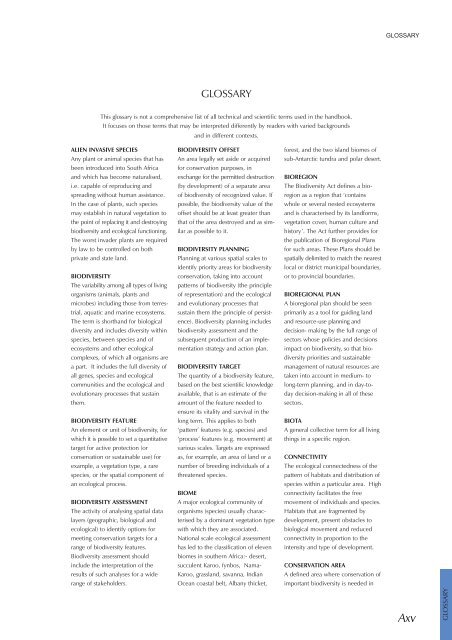Mpumalanga Biodiversity Conservation Plan Handbook - bgis-sanbi
Mpumalanga Biodiversity Conservation Plan Handbook - bgis-sanbi
Mpumalanga Biodiversity Conservation Plan Handbook - bgis-sanbi
Create successful ePaper yourself
Turn your PDF publications into a flip-book with our unique Google optimized e-Paper software.
GLOSSARY<br />
This glossary is not a comprehensive list of all technical and scientific terms used in the handbook.<br />
It focuses on those terms that may be interpreted differently by readers with varied backgrounds<br />
ALIEN INVASIVE SPECIES<br />
Any plant or animal species that has<br />
been introduced into South Africa<br />
and which has become naturalised,<br />
i.e. capable of reproducing and<br />
spreading without human assistance.<br />
In the case of plants, such species<br />
may establish in natural vegetation to<br />
the point of replacing it and destroying<br />
biodiversity and ecological functioning.<br />
The worst invader plants are required<br />
by law to be controlled on both<br />
private and state land.<br />
BIODIVERSITY<br />
The variability among all types of living<br />
organisms (animals, plants and<br />
microbes) including those from terrestrial,<br />
aquatic and marine ecosystems.<br />
The term is shorthand for biological<br />
diversity and includes diversity within<br />
species, between species and of<br />
ecosystems and other ecological<br />
complexes, of which all organisms are<br />
a part. It includes the full diversity of<br />
all genes, species and ecological<br />
communities and the ecological and<br />
evolutionary processes that sustain<br />
them.<br />
BIODIVERSITY FEATURE<br />
An element or unit of biodiversity, for<br />
which it is possible to set a quantitative<br />
target for active protection (or<br />
conservation or sustainable use) for<br />
example, a vegetation type, a rare<br />
species, or the spatial component of<br />
an ecological process.<br />
BIODIVERSITY ASSESSMENT<br />
The activity of analysing spatial data<br />
layers (geographic, biological and<br />
ecological) to identify options for<br />
meeting conservation targets for a<br />
range of biodiversity features.<br />
<strong>Biodiversity</strong> assessment should<br />
include the interpretation of the<br />
results of such analyses for a wide<br />
range of stakeholders.<br />
and in different contexts.<br />
BIODIVERSITY OFFSET<br />
An area legally set aside or acquired<br />
for conservation purposes, in<br />
exchange for the permitted destruction<br />
(by development) of a separate area<br />
of biodiversity of recognized value. If<br />
possible, the biodiversity value of the<br />
offset should be at least greater than<br />
that of the area destroyed and as similar<br />
as possible to it.<br />
BIODIVERSITY PLANNING<br />
<strong>Plan</strong>ning at various spatial scales to<br />
identify priority areas for biodiversity<br />
conservation, taking into account<br />
patterns of biodiversity (the principle<br />
of representation) and the ecological<br />
and evolutionary processes that<br />
sustain them (the principle of persistence).<br />
<strong>Biodiversity</strong> planning includes<br />
biodiversity assessment and the<br />
subsequent production of an implementation<br />
strategy and action plan.<br />
BIODIVERSITY TARGET<br />
The quantity of a biodiversity feature,<br />
based on the best scientific knowledge<br />
available, that is an estimate of the<br />
amount of the feature needed to<br />
ensure its vitality and survival in the<br />
long term. This applies to both<br />
‘pattern’ features (e.g. species) and<br />
‘process’ features (e.g. movement) at<br />
various scales. Targets are expressed<br />
as, for example, an area of land or a<br />
number of breeding individuals of a<br />
threatened species.<br />
BIOME<br />
A major ecological community of<br />
organisms (species) usually characterised<br />
by a dominant vegetation type<br />
with which they are associated.<br />
National scale ecological assessment<br />
has led to the classification of eleven<br />
biomes in southern Africa:- desert,<br />
succulent Karoo, fynbos, Nama-<br />
Karoo, grassland, savanna, Indian<br />
Ocean coastal belt, Albany thicket,<br />
forest, and the two island biomes of<br />
sub-Antarctic tundra and polar desert.<br />
BIOREGION<br />
The <strong>Biodiversity</strong> Act defines a bioregion<br />
as a region that ‘contains<br />
whole or several nested ecosystems<br />
and is characterised by its landforms,<br />
vegetation cover, human culture and<br />
history’. The Act further provides for<br />
the publication of Bioregional <strong>Plan</strong>s<br />
for such areas. These <strong>Plan</strong>s should be<br />
spatially delimited to match the nearest<br />
local or district municipal boundaries,<br />
or to provincial boundaries.<br />
BIOREGIONAL PLAN<br />
A bioregional plan should be seen<br />
primarily as a tool for guiding land<br />
and resource-use planning and<br />
decision- making by the full range of<br />
sectors whose policies and decisions<br />
impact on biodiversity, so that biodiversity<br />
priorities and sustainable<br />
management of natural resources are<br />
taken into account in medium- to<br />
long-term planning, and in day-today<br />
decision-making in all of these<br />
sectors.<br />
BIOTA<br />
A general collective term for all living<br />
things in a specific region.<br />
CONNECTIVITY<br />
The ecological connectedness of the<br />
pattern of habitats and distribution of<br />
species within a particular area. High<br />
connectivity facilitates the free<br />
movement of individuals and species.<br />
Habitats that are fragmented by<br />
development, present obstacles to<br />
biological movement and reduced<br />
connectivity in proportion to the<br />
intensity and type of development.<br />
CONSERVATION AREA<br />
A defined area where conservation of<br />
important biodiversity is needed in<br />
GLOSSARY<br />
Axv<br />
GLOSSARY

















